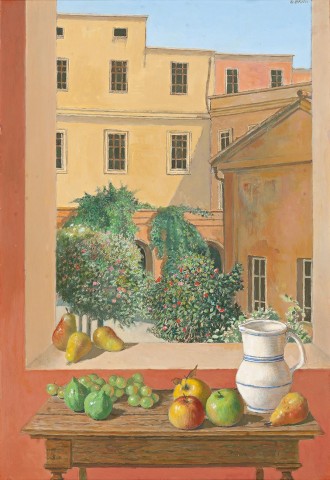STILL LIFE ON A TERRACE, 1990 – 93
JUSTIN O’BRIEN
oil on paper on board
48.0 x 33.0 cm
signed upper right: O’BRIEN
bears inscription on backing verso: 17
Australian Galleries, Sydney (labels attached verso)
Private collection, Sydney, acquired from the above in 1993
Paintings by Justin O’Brien, Australian Galleries, Sydney, 26 – 31 July 1993, cat. 17
Still Life on a Terrace, 1993 is a superb example of Justin O’Brien’s late series of ‘window paintings’. By 1993, O’Brien was residing permanently in the Papal city, undertaking daily trips to the Vatican and visiting the Vatican Museums, in which one of his paintings now hangs. The epitome of O’Brien’s naturalism, this still life is an exercise in mimesis and challenges the very purpose of pictorial representation. Remaining steadfast to his resolve to paint physical, terrestrial beauty, O’Brien worked tirelessly into his eighth decade, through the last years of his life in Italy.
Still Life on a Terrace is a carefully considered study, delicately detailed and vibrantly coloured. The vision is of the window of his apartment close to Via Alberico II, within the old city center of the Italian capital, a stone’s throw from the roman Castel Sant’Angelo on the banks of the river Tiber.1 Whilst it is similar in composition to other ‘window paintings’ by the artist – in particular The Window No. 2, 1978, formerly of the David Clark AO Collection – the world beyond the window frame is undeniably Roman, the internal courtyard filled with creeping ivy and flowering fruit trees. The rich terracotta and cream colouring of the facades of the neighbouring buildings also point to its carefully recorded geographical setting. In his last interview with Christine France, published in the revised edition of her monograph, O’Brien expressed his enjoyment of the ‘much better view … which has beautiful trees in the courtyard and from the back I look onto the Nigerian Embassy’.2
The arrangement of an offering of fruit on the windowsill, the still life subject of this painting, is simple and evocative, bringing to mind the work of the French Post-Impressionist Cézanne. The waxy surfaces of the fruits are immediately apparent against the coarse texture of the window frame and wooden table. Presenting a convincing facsimile of a physical window frame, O’Brien’s Still Life on a Terrace seems to radiate the warmth and fragrance of an Italian summer. In this calm abundance, O’Brien has captured the serenity of a spiritual life and invites its quiet contemplation.
O’Brien was an artist always in close stylistic discussion with the great artists of Western art history. The strong emphasis on tight linear composition, a smooth and flat finish and vibrant pure colours are all aspects that he gleaned, not from his antipodean peers but from key figures of the Italian Renaissance. The polished restraint that pervades his pictures can be likened to the passionless exactitude of these Italian masters, in particular Piero della Francesca, who used colour and light to translate divine providence in his compositions.
1. Grishin, S., ‘An Australian Painter in Rome: Justin O’Brien’, Art and Australia, Sam Ure Smith at the Fine Arts Press, Sydney, vol. 21, no. 4, Winter 1984, p. 493
2. France, C., Justin O’Brien: Image and Icon, Craftsman House, Sydney, revised edition, 1997, p. 36
LUCIE REEVES-SMITH
